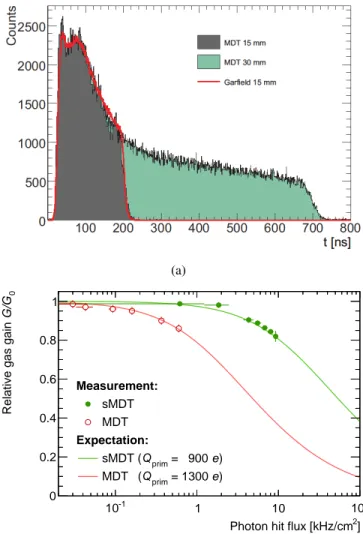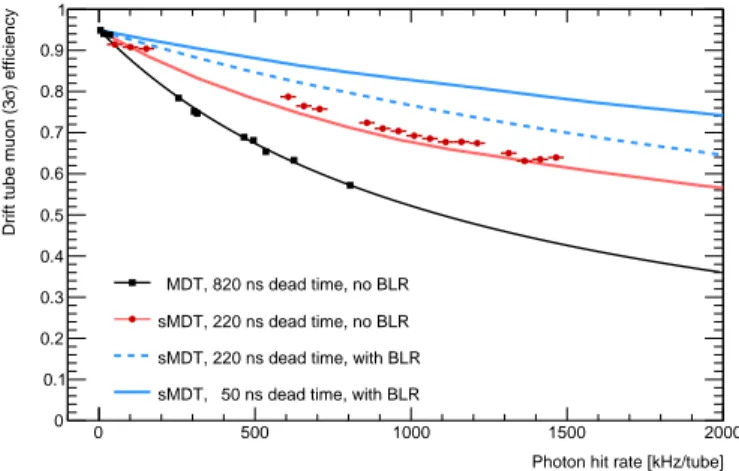Precision Muon Tracking Detectors for High-Energy Hadron Colliders
Ph. Gadow, O. Kortner, H. Kroha ∗ , R. Richter
Max-Planck-Institut f¨ur Physik, F¨ohringer Ring 6, D-80805 Munich, Germany
Abstract—Small-diameter muon drift tube (sMDT) chambers with 15 mm tube diameter are a cost-effective technology for high-precision muon tracking over large areas at high back- ground rates as expected at future high-energy hadron colliders including HL-LHC. The chamber design and construction pro- cedures have been optimized for mass production and provide sense wire positioning accuracy of better than 10 µm. The rate capability of the sMDT chambers has been extensively tested at the CERN Gamma Irradiation Facility. It exceeds the one of the ATLAS muon drift tube (MDT) chambers, which are operated at unprecedentedly high background rates of neutrons and γ-rays, by an order of magnitude, which is sufficient for almost the whole of the muon detector acceptance at FCC-hh at maximum luminosity. sMDT operational and construction experience exists from ATLAS muon spectrometer upgrades which are in progress or under preparation for LHC Phase 1 and 2.
I. I NTRODUCTION
Drift tube detectors are a cost-effective technology for high-precision muon tracking over large areas. Monitored drift tube (MDT) chambers with 30 mm diameter drift tubes are used for precision muon tracking in the ATLAS muon spectrometer [1]. Operated with Ar:CO 2 (93:7) drift gas at 3 bar, they provide excellent spatial resolution and tracking efficiency independent of (or even improving with) the track incident angle, and are not susceptible to aging. Already at the LHC design luminosity, the ATLAS MDT chambers are exposed to unprecedentedly high background rates of neutrons and γ-rays produced in interactions of the proton- proton collision products in the detector and shielding. At high-luminosity LHC (HL-LHC) as well as at future high- energy hadron colliders like FCC-hh, the background fluxes in the muon spectrometers are expected to increase roughly proportional to the luminosity by factors of up to 7 and 30, respectively. The maximum background flux MDT chambers are exposed to in ATLAS at the LHC design luminosity is 500 Hz/cm 2 while at FCC-hh the maximum expected rate in sMDT chambers is about 13 kHz/cm 2 .
Small-diameter muon drift tube (sMDT) chambers [2] with standard industrial aluminum tubes of 15 mm outer diameter and 0.4 mm wall thickness, i.e. with half of the MDT drift tube diameter, have been developed in order to increase the spatial resolution and muon detection efficiency by more than an order of magnitude and to allow for larger numbers of drift tube layers within the available detector volume in order to further improve the tracking resolution and efficiency, especially at
∗ Corresponding author: kroha@mpp.mpg.de
(a)
2 ] Photon hit flux [kHz/cm
10 -1 1 10 10 2
0 G/G Relative gas gain
0 0.2 0.4 0.6 0.8 1
Measurement:
sMDT MDT Expectation:
) e 900 0
prim = Q sMDT (
) e = 1300 Q prim
( s MDT
(b)
Fig. 1: (a) Drift time spectra of MDT (light grey) and sMDT tubes (dark grey). (b) Gas gain measured as a function of γ background flux for MDT (open circles) and sMDT tubes (full circles) compared to expectations.
high background rates. For ATLAS upgrades the gas compo- sition and pressure and the gas gain of 20000 as well as the front-end electronics chip layout are kept unchanged, making 15 mm tube diameter the optimum choice also with respect to mechanical precision and stability and electronics integration.
Under these operating conditions, long-term irradiation tests have shown no aging up 9 C/cm charge accumulation on the wire, which is 15 times the requirement for the ATLAS MDTs.
For experiments beyond HL-LHC, further optimisation of the
2

